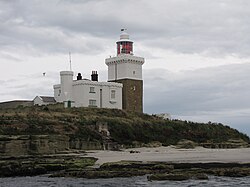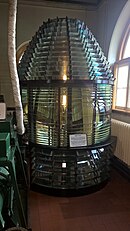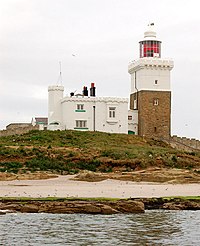Coquet Lighthouse
| Coquet Lighthouse | |||
| Coquet Island | |||
 The lighthouse | |||
| Location | |||
| Grid reference: | NU29300452 | ||
| Location: | 55°20’2"N, 1°32’23"W | ||
| Characteristics | |||
| Height: | 72 feet | ||
| Tower shape: | square tower with balcony and lantern | ||
| Tower marking: | unpainted lower tower, white upper tower and lantern | ||
| Light: | Fl (3) WR 20s. | ||
| Intensity: | white: 155,000 candela red: 21,830 candela | ||
| Focal height: | 82 feet | ||
| Range: | white: 19 nautical miles red: 15 nautical miles | ||
| History | |||
| Built 1841 | |||
| Information | |||
| Owned by: | Trinity House | ||
Coquet Lighthouse stands on Coquet Island. It was built by Trinity House in 1841 at a cost of £3,268. James Walker designed the lighthouse, which is a white square tower of sandstone, with walls more than one metre thick, surrounded by a turreted parapet. The first keeper at Coquet Lighthouse was William Darling, the elder brother of Grace Darling.
The lighthouse was initially provided with a large (first-order) fixed dioptric along with a set of mirrors (which were replaced with refracting prisms ten years later); the lens was by Isaac Cookson & co. of Newcastle upon Tyne.[1] The lamp was oil-fuelled. In 1854 red sectors were added, to warn ships of Hauxley Point to the south and Boulmer Rocks to the north.[1] Later, in 1870, a separate sector light was added, pointing south from a lower window in the tower.[2] In 1891 both lights were made much more powerful; the main lamp was replaced with an eight-wick mineral-oil burner,[3] and its character was changed to occulting (being eclipsed for 2.5 seconds every minute).[4]
An explosive fog signal was established at the lighthouse in 1902, which sounded once every seven-and-a-half minutes;[5] later sounding every three minutes, it was still in use in the 1970s.[6] The light was electrified in 1976; up until this date a paraffin vapour burner provided the main light, and an old-style Argand lamp provided the sector light.[7]
In 1990 the lighthouse was automated, at which point a revolving array of quartz halogen sealed beam lamps were installed in place of the old optic,[8][9] with columns of lamps grouped in threes on a rotating pedestal, so as to display three flashes every 30 seconds. Subsequently, these were replaced by a small revolving optic, mounted on an AGA PRB gearless drive.
Coquet's light has been solar powered since 2008.[10]
After its removal from the tower, the original 1841–1851 optic was exhibited (along with the old occulting apparatus) at the Trinity House National Lighthouse Museum.[11] After the museum closed they were loaned to Souter Lighthouse where they were displayed for a number of years.[12]
Outside links
References
- ↑ 1.0 1.1 "Lighthouse management : the report of the Royal Commissioners on Lights, Buoys, and Beacons, 1861, examined and refuted Vol. 2". 1861. pp. 94. https://archive.org/stream/lighthousemanage02blak#page/94/mode/1up.
- ↑ London Gazette, Issue: 23691, Page: 5920, 27 December 1870.
- ↑ Price Edwards, E. (12 February 1892). "Burning Oils for Lighthouses and Lightships". Journal of the Society of Arts XL (2,047): 269.
- ↑ London Gazette, Issue: 26226, Page: 6235, 24 November 1891.
- ↑ London Gazette, Issue: 27462, Page: 5124, 8 August 1902.
- ↑ Jackson, Derrick (1975). Lighthouses of England and Wales. Newton Abbott, Devon: David & Charles. p. 66.
- ↑ Bland Hague, Douglas; Christie, Rosemary (1975). Lighthouses Their Architecture, History and Archaeology. Llandysul: Gomer Press. p. 157.
- ↑ Woodman, Richard; Wilson, Jane (2002). The Lighthouses of Trinity House. Bradford-on-Avon, Wilts.: Thomas Reed. pp. 64–66.
- ↑ Photo, 1990.
- ↑ "Coquet Island". https://www.visitnorthumberland.com/nature-wildlife/coquet-island&ssid=384021.
- ↑ "The Trinity House National Lighthouse Museum". http://www.lighthousedigest.com/Digest/StoryPage.cfm?StoryKey=399.
- ↑ "Souter Lighthouse (National Trust)". http://northern-leisure.co.uk/venue.php?venueId=2335.
- Rowlett, Russ: Lighthouses of Northeastern England – The Lighthouse Directory (University of North Carolina at Chapel Hill)

